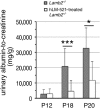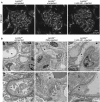Laminin-521 Protein Therapy for Glomerular Basement Membrane and Podocyte Abnormalities in a Model of Pierson Syndrome
- PMID: 29472414
- PMCID: PMC5967757
- DOI: 10.1681/ASN.2017060690
Laminin-521 Protein Therapy for Glomerular Basement Membrane and Podocyte Abnormalities in a Model of Pierson Syndrome
Abstract
Background Laminin α5β2γ1 (LM-521) is a major component of the GBM. Mutations in LAMB2 that prevent LM-521 synthesis and/or secretion cause Pierson syndrome, a rare congenital nephrotic syndrome with diffuse mesangial sclerosis and ocular and neurologic defects. Because the GBM is uniquely accessible to plasma, which permeates endothelial cell fenestrae, we hypothesized that intravenous delivery of LM-521 could replace the missing LM-521 in the GBM of Lamb2 mutant mice and restore glomerular permselectivity.Methods We injected human LM-521 (hLM-521), a macromolecule of approximately 800 kD, into the retro-orbital sinus of Lamb2-/- pups daily. Deposition of hLM-521 into the GBM was investigated by fluorescence microscopy. We assayed the effects of hLM-521 on glomerular permselectivity by urinalysis and the effects on podocytes by desmin immunostaining and ultrastructural analysis of podocyte architecture.Results Injected hLM-521 rapidly and stably accumulated in the GBM of all glomeruli. Super-resolution imaging showed that hLM-521 accumulated in the correct orientation in the GBM, primarily on the endothelial aspect. Treatment with hLM-521 greatly reduced the expression of the podocyte injury marker desmin and attenuated the foot process effacement observed in untreated pups. Moreover, treatment with hLM-521 delayed the onset of proteinuria but did not prevent nephrotic syndrome, perhaps due to its absence from the podocyte aspect of the GBM.Conclusions These studies show that GBM composition and function can be altered in vivovia vascular delivery of even very large proteins, which may advance therapeutic options for patients with abnormal GBM composition, whether genetic or acquired.
Keywords: glomerular basement membrane; glomerular filtration barrier; laminin; podocyte.
Copyright © 2018 by the American Society of Nephrology.
Figures








Comment in
-
Repairing the GBM Step by Step.J Am Soc Nephrol. 2018 May;29(5):1346-1347. doi: 10.1681/ASN.2018030294. Epub 2018 Apr 12. J Am Soc Nephrol. 2018. PMID: 29650536 Free PMC article. No abstract available.
Similar articles
-
Laminin β2 gene missense mutation produces endoplasmic reticulum stress in podocytes.J Am Soc Nephrol. 2013 Jul;24(8):1223-33. doi: 10.1681/ASN.2012121149. Epub 2013 May 30. J Am Soc Nephrol. 2013. PMID: 23723427 Free PMC article.
-
Alport syndrome and Pierson syndrome: Diseases of the glomerular basement membrane.Matrix Biol. 2018 Oct;71-72:250-261. doi: 10.1016/j.matbio.2018.04.008. Epub 2018 Apr 16. Matrix Biol. 2018. PMID: 29673759 Free PMC article. Review.
-
Forced expression of laminin beta1 in podocytes prevents nephrotic syndrome in mice lacking laminin beta2, a model for Pierson syndrome.Proc Natl Acad Sci U S A. 2011 Sep 13;108(37):15348-53. doi: 10.1073/pnas.1108269108. Epub 2011 Aug 29. Proc Natl Acad Sci U S A. 2011. PMID: 21876163 Free PMC article.
-
Pathogenicity of a Human Laminin β2 Mutation Revealed in Models of Alport Syndrome.J Am Soc Nephrol. 2018 Mar;29(3):949-960. doi: 10.1681/ASN.2017090997. Epub 2017 Dec 20. J Am Soc Nephrol. 2018. PMID: 29263159 Free PMC article.
-
The glomerular basement membrane as a barrier to albumin.Nat Rev Nephrol. 2013 Aug;9(8):470-7. doi: 10.1038/nrneph.2013.109. Epub 2013 Jun 18. Nat Rev Nephrol. 2013. PMID: 23774818 Free PMC article. Review.
Cited by
-
Laminin Polymerization and Inherited Disease: Lessons From Genetics.Front Genet. 2021 Aug 12;12:707087. doi: 10.3389/fgene.2021.707087. eCollection 2021. Front Genet. 2021. PMID: 34456976 Free PMC article. Review.
-
[Research progress on monogenic inherited glomerular diseases with central nervous system symptoms].Zhongguo Dang Dai Er Ke Za Zhi. 2024 Jun 15;26(6):652-658. doi: 10.7499/j.issn.1008-8830.2312054. Zhongguo Dang Dai Er Ke Za Zhi. 2024. PMID: 38926384 Free PMC article. Review. Chinese.
-
Complexities of the glomerular basement membrane.Nat Rev Nephrol. 2021 Feb;17(2):112-127. doi: 10.1038/s41581-020-0329-y. Epub 2020 Aug 24. Nat Rev Nephrol. 2021. PMID: 32839582 Review.
-
Super-Resolution Microscopy: A Technique to Revolutionize Research and Diagnosis of Glomerulopathies.Glomerular Dis. 2022 Dec 18;3(1):19-28. doi: 10.1159/000528713. eCollection 2023 Jan-Dec. Glomerular Dis. 2022. PMID: 36816428 Free PMC article. Review.
-
Apelinergic system in the kidney: implications for diabetic kidney disease.Physiol Rep. 2018 Dec;6(23):e13939. doi: 10.14814/phy2.13939. Physiol Rep. 2018. PMID: 30548130 Free PMC article.
References
-
- Barker DF, Hostikka SL, Zhou J, Chow LT, Oliphant AR, Gerken SC, et al. .: Identification of mutations in the COL4A5 collagen gene in Alport syndrome. Science 248: 1224–1227, 1990 - PubMed
Publication types
MeSH terms
Substances
Supplementary concepts
Grants and funding
LinkOut - more resources
Full Text Sources
Other Literature Sources
Molecular Biology Databases

